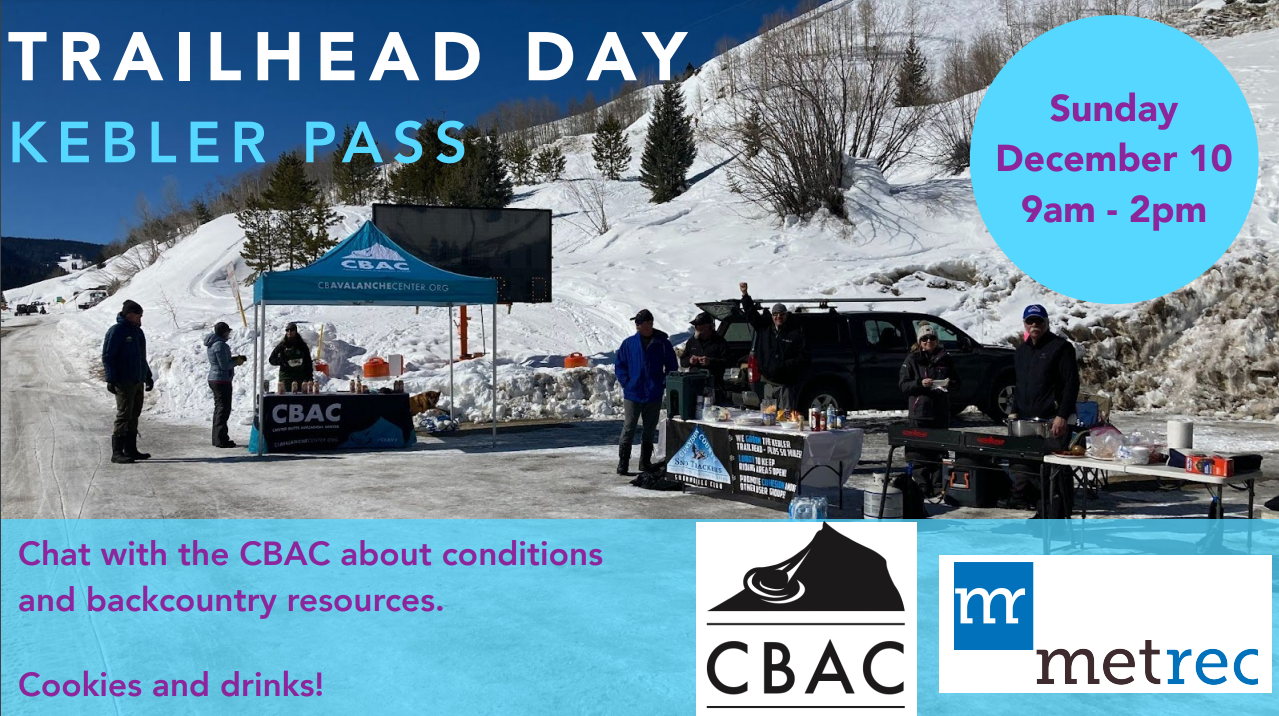MSP is hosting their March Meltdown at the Elevation Hotel deck Saturday, March 30 1-6 p.m. Live music, Jack Daniels drink specials and a drawing for skis, coolers and other great items. The party is free and proceeds to benefit the CBAC.
Trailhead Day – Cement Creek
Join us at the Cement Creek Trailhead for Cookies, Coffee, and Backcountry Beta. Saturday March 23, 9am-2pm
Fireside Chat – GT Snow Safety
Sunday 3/24, 7pm at the Public House 202 Elk Ave. Join us for a panel discussion with past snow safety directors and local legends from the Grand Traverse. Learn about the history of the race, the efforts to keep everyone safe, and all the associated tall tales. Lots of great stories, most of them true!
Fireside Chat with George Lowe! 3/3 6pm
Join us for another Fireside Chat, this time with American Mountaineering legend George Lowe. 6pm, Sunday March 3rd, Mallardi Theater, 403 2nd Street CB.
Fireside Chat : Buried!
Join us for a snowpack update followed by a discussion of a real – life avalanche burial and rescue with local snowmobiler Kain Leonard. Sunday February 4th, 6pm at the High Alpine Brewing Company in Gunnison.
Capital Campaign
Dear CBAC Community,
Our motto is, “We do it every day,” and for 24 years our commitment to safeguarding lives in our valley through professional weather and avalanche forecasting has been unwavering.
Since our humble beginnings in a basement on Sopris Avenue, our center has grown and evolved and set the standard for excellence as a locally run avalanche center in this critical public safety service. The success of our model has others recognizing the value of what the CBAC is doing and since we started, eight similar centers have opened throughout the West and in Alaska.
Having a forecast team that lives in the area brings unmatched expertise in understanding our local snowpack, weather patterns, and the intricacies of our terrain. It is the backbone of our safety efforts in the valley.
Yet, like so many other entities in the Gunnison Valley, we are not immune to current economic challenges and keeping experienced and qualified staff in place has become more and more difficult. We’re at a pivotal moment and we need your support.
To address that, we’ve launched a Capital Campaign aimed at establishing an endowment fund dedicated to our forecast staff. Our goal is to raise $50,000 and we’re excited to say that we’ve already received a generous offer to match the first $10,000 in donations.
Your partnership in this campaign is a direct investment in safety and expertise. Your commitment to our cause will empower us to retain and support our exceptional staff, not just this year, but for years to come, thereby safeguarding our ability to provide top-tier avalanche forecasting.
As a token of our gratitude, we have a CBAC embroidered down coat from our friends at Big Agnes for every donation of $1000 or more. In addition, everyone who participates in the Capital Campaign will be entered into a drawing to spend a day in the field with a forecaster to see exactly what they do, and how they do it.
My hope is that you see the value in what we do and join us in securing the future of avalanche forecasting in our valley. Your generosity will make a tangible impact in our ability to provide a critical public safety service and ensure that we continue to “do it every day.”
Please visit https://crm.bloomerang.co/HostedDonation?ApiKey=pub_fca5b45d-4a03-11e7-afbe-024e165d44b3&WidgetId=59574272 to contribute.
Thank you and here’s to a safe and snowy 2024!
Than Acuff
Executive Director
Crested Butte Avalanche Center
Avalanche Terrain Map for Crested Butte
We’re excited to release an Avalanche Terrain Exposure Scale (ATES) map of the Crested Butte forecast area to help you with tour planning. ATES is a scale used to categorize the severity of avalanche exposure, strictly based on the landscape, regardless of snowpack conditions. The ATES scale classifies terrain into five categories based on slope angle, forest density, slope shape, terrain traps, avalanche frequency/magnitude, starting zone size and density, runout zone characteristics, interaction with avalanche paths, and route options for managing exposure. See the draft definitions of the five-level scale (V.2) below.

For this year-long project, we partnered with OnX and Beacon Guidebooks to categorize terrain around Crested Butte as Simple (Class 1 = Green), Challenging (Class 2 = Blue), Complex (Class 3 = Black), and Extreme (Class 4 = Red). We used an automated model approach called AutoATES, and calibrated the release areas and runout models using historical data from our avalanche records and local experience to tweak model inputs such as tree density and alpha angles. Although models are never perfect, the map should provide a useful resource for route planning and identifying what terrain is relatively more or less exposed to avalanche hazards. Remember that this map is independent of snowpack conditions; some days it is safe to travel in complex terrain, and other days it is dangerous. And you can still get into trouble in simple terrain under certain conditions. This map is available for free on our website here, or under the “Resources” tab on our website menu. Bookmark it as another tool! You can also use this map offline in the field using the OnX app (subscription required).













